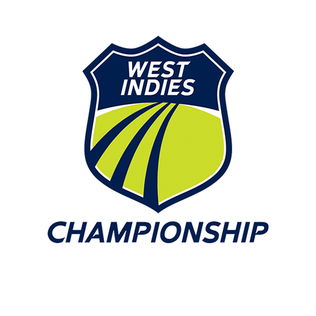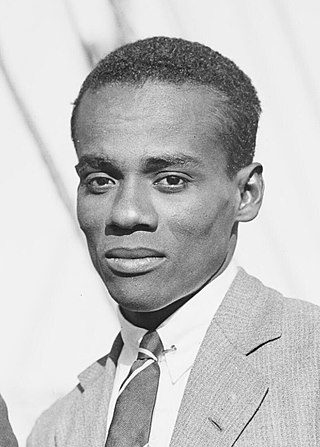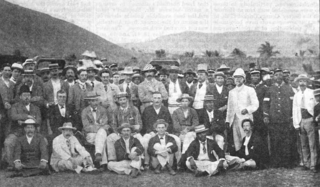Related Research Articles

The Barbados national cricket team is the national cricket team of Barbados, organised by the Barbados Cricket Association (BCA). Barbados is a member of the West Indies Cricket Board (WICB), which is a member of the International Cricket Council (ICC) in its own right, and Barbadians play internationally for the West Indies cricket team.
The Combined Islands cricket team was a cricket team that represented the cricket-playing islands of the Lesser Antilles, excluding Barbados and Trinidad and Tobago who fielded their own teams. They played in 13 Shell Shield tournaments from 1965–66 to 1980–81, when they won their first title and were subsequently disbanded into Leeward Islands and Windward Islands. Those two teams had first-class status before 1980–81, but competed together in the Shell Shield.

The Regional Four Day Competition, formerly known as the Shell Shield, Red Stripe, Busta and Carib Beer Cup, is the West Indies's first-class cricket competition that's run by Cricket West Indies. In the 2013–2014 season the winner of the tournament was awarded the WICB President's Trophy while the winners of the knockout competition were awarded the George Headley/Everton Weekes trophy. In a few previous seasons the winners of the tournament were awarded the Headley/Weekes trophy. On from the 2016–17 season, the Competition was sponsored by Digicel and was known as the Digicel Four Day Championship. Since 2019–20, the competition has been renamed as the West Indies Championship.
The 2005–06 West Indian cricket season includes all domestic cricket matches played by senior teams with first-class status in the West Indies between October 2005 and March 2006, and also the international feats of the West Indies team, who is not scheduled to play any home games during this period but are to play home matches during April, May and June 2006. The season began on 2005-10-03 with the first matches of the one-day KFC Cup and is scheduled to last until 2006-03-19 when England A depart after their tour which will include one-day and first-class matches against the West Indies A team. The West Indies will not play any home Tests during their home season, but they have toured Australia, and toured New Zealand in February and March, immediately after the conclusion of the 2005-06 Carib Beer Cup, the first-class competition.
Maurius Pacheco Fernandes, known as Maurice Fernandes, was a West Indian Test cricketer who played first-class cricket for British Guiana between 1922 and 1932. He made two Test appearances for the West Indies, in 1928 and 1930. Fernandes played as a right-handed top-order batsman and occasional wicket-keeper. He scored 2,087 first-class runs in 46 appearances at an average of 28.20.

Wilton H. St Hill was a West Indian international cricketer who played in West Indies' first Test match during their inaugural Test tour of England. A right-handed batman who played in a variety of batting positions, he represented Trinidad in first-class cricket between 1912 and 1930 and played in three Test matches in total. Although his Test record was poor, he was highly regarded in Trinidad. In particular, writer C. L. R. James considered St Hill to be among the top batsmen in the world and dedicated a chapter of Beyond a Boundary to him. At the peak of his career, Lord Harris described him as the best batsman in the West Indies.

Joseph A. Small was a West Indian cricketer who played in West Indies' first Test in their inaugural Test tour of England. He scored the first half century for a West Indies player in Test cricket and played two further Test matches in his career. An all-rounder, he played domestic cricket for Trinidad between 1909 and 1932.

Edwin Lloyd St Hill was a Trinidadian cricketer who played two Test matches for the West Indies in 1930. His brothers, Wilton and Cyl, also played for Trinidad and Tobago; in addition, the former played Test matches for the West Indies.
Cameron Wilberforce Smith is a former West Indian international cricketer from Barbados who played in five Test matches from 1960 to 1962.
The seventh team of English cricketers toured the West Indies in the 1912–13 season. The tour was organised by MCC. As in 1910–11, the team was captained by AWF Somerset. The tour involved a total of 9 matches, all of which are regarded as first-class, between January and March 1913.
The English cricket team in the West Indies in 1934–35 was a cricket touring party sent to the West Indies under the auspices of the Marylebone Cricket Club for a tour lasting 2+1⁄2 months in 1934–35. The team played four Test matches against the West Indian cricket team, winning one match but losing two – the first series defeat of an English side by the West Indies.
Lord Brackley's XI was the fifth team of English cricketers to tour the West Indies, playing in the 1904–05 season. The team was captained by John Egerton, 4th Earl of Ellesmere and played a total of 20 matches between January and April 1905, of which ten are regarded as first-class.

A team of amateur cricketers under the captaincy of Robert Slade Lucas toured the West Indies in the 1894–95 season, playing matches between January and April 1895. They played a total of 16 matches of which eight are regarded as first-class. It was the first visit of an English cricket team to the West Indies.
A team of amateur cricketers under the captaincy of Arthur Priestley toured the West Indies in the 1896–97 season, playing matches between January and March 1897. They played a total of sixteen matches of which nine are regarded as first-class. They did not play in British Guiana.
This article describes the history of cricket in the West Indies from 1919 to 1945.
This article describes the history of West Indies cricket from 1946 to 1970.
Leonard Alphonso Harris was a West Indian cricketer who played for the Leeward Islands between 1958 and 1971. An opening batsman for much of his career, and occasional bowler in his final seasons, Harris played in West Indian first class cricket, as well as facing the MCC team, England and Australia during his career. He played 27 matches, scoring nearly 1,400 runs at 29.04, including a century, and taking 15 wickets at 19.46. He then went on to play lower-level cricket for St. Kitts until 1976, and helped create the first cricket academy in the Leeward Islands.
The 1965–66 Shell Shield season was the inaugural edition of what is now the Regional Four Day Competition, the domestic first-class cricket competition for the countries of the West Indies Cricket Board (WICB). The tournament was sponsored by Royal Dutch Shell, with matches played from 27 January to 14 March 1966.
The 1966–67 Shell Shield season was the second edition of what is now the Regional Four Day Competition, the domestic first-class cricket competition for the countries of the West Indies Cricket Board (WICB). The tournament was sponsored by Royal Dutch Shell, with matches played from 8 February to 3 April 1967.
The 1968–69 Shell Shield season was the third edition of what is now the Regional Four Day Competition, the domestic first-class cricket competition for the countries of the West Indies Cricket Board (WICB). The tournament was sponsored by Royal Dutch Shell, with matches played from 17 January to 6 March 1969.
References
- ↑ Barbados Cricketers 1865–1990, page 4, by Philip Thorn